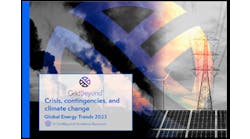After significant delays thanks largely to COVID-19-related supply chain issues, Australia’s first renewable hydrogen microgrid was commissioned earlier this year. On Monday, the Western Australian (WA) government and Horizon Power released a report outlining their learnings to date, including details on the integration of hydrogen and microgrid technologies, costs, regulatory requirements and community sentiment around hydrogen.
Acting Energy Minister Tony Buti declared that the Public Commissioning Knowledge Sharing Report “confirms the great opportunity for hydrogen to play a role in our state's energy transition.”
Located in Denham, WA, about 500 miles north of Perth, the Denham Renewable Hydrogen Microgrid integrates hydrogen components into an existing off-grid hybrid microgrid that had relied on diesel, wind, a 704-kW solar farm and a battery energy storage system.
The system now includes a 348-kW hydrogen electrolyzer and a 100-kW fuel cell. The system will pass city drinking water through a reverse osmosis system prior to its use by the electrolyzer. The system’s daily consumption of water will be no more than that of four typical households, according to Horizon Power.
It is expected that the hydrogen microgrid will offset nearly 37,000 gallons (140,000 liters) of diesel fuel each year and produce enough energy to power roughly 20% of Denham’s residences and businesses. Denham has about 800 permanent residents.
"This innovative project helps to reduce our reliance on diesel in remote areas, delivering cleaner, affordable and reliable power for Denham,” said Roger Cook, Western Australia’s premier.
Proof of concept
The microgrid was built and is operated by Horizon Power, the primary power producer in Western Australia. Horizon has been a proponent of microgrids for more than a decade, testing and advancing a variety of microgrid-related technologies, including the use of distributed energy resources management systems and long-duration energy storage systems.
With a service territory that spans roughly 1.4 million square miles, much of it remote, Horizon has built nearly three dozen microgrids. The company recently took over an additional 117 microgrids from the Western Australia Department of Communities, which it will be integrating over the next year.
The Denham hydrogen microgrid marks the first foray into hydrogen production for both Horizon and the WA government, which invested $5.7 million in the project. Additional funding was provided by the Australian Renewable Energy Agency’s Advancing Renewables Program.
The goal is not to generate as much renewable hydrogen as possible or even produce it as cheaply as possible, according to the report. Rather Horizon and the WA government hope to prove that hydrogen energy storage systems are viable alternatives to diesel-powered generators –– and therefore can be utilized at other remote microgrid sites to “time shift” the use of renewable energy. Time shifting involves storing excess energy generated during the day for use overnight.
"As we retire state-owned coal-fired power and embrace renewable energy, hydrogen could play a key role in powering our state while creating jobs and business opportunities through new export markets,” Buti said.
Report to advance learnings
Horizon Power will monitor the system for the next year, gathering data to determine where improvements can be made.
This week’s report outlines key learnings gleaned around technology, costs, regulatory requirements and community sentiment around hydrogen.
"The knowledge we've gained through this pilot project will help to guide future remote uses of renewable hydrogen across WA and the rest of the nation,” Cook said.
In the U.S., there are a number of hydrogen-powered microgrid pilots underway. Vertiv, an Ohio-based critical infrastructure provider, recently launched a microgrid that includes a 400-kW hydrogen fuel cell. The company is demonstrating how the microgrid works with its data center infrastructure technologies.
In California, Plug Power is working on what it describes as the largest U.S. hydrogen-powered microgrid in Calistoga, while Southern California Gas Company continues to test the use of renewable hydrogen in residential microgrids at its [H2] Innovation Experience in Downey.








